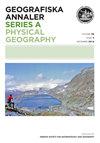Summer mean temperature reconstruction during the past 285 years based on tree-ring in northern Gaoligong Mountains, northwestern Yunnan of China
IF 1.8
4区 地球科学
Q3 GEOGRAPHY, PHYSICAL
Geografiska Annaler Series A-Physical Geography
Pub Date : 2020-12-08
DOI:10.1080/04353676.2020.1854012
引用次数: 1
Abstract
ABSTRACT Historical temperature reconstructions enable us to understand the long-term thermal variation feature of a region. We developed a tree-ring width chronology of the coniferous species Tsuga dumosa (D. Don) Eichler (Himalayan Hemlock) growing in the northern Gaoligong Mountains, northwestern Yunnan province of China. The climate-tree growth relationship analysis indicated that summer mean temperature was the main limiting factor of the radial growth of Himalayan Hemlock. Accordingly, using a linear regression model, we reconstructed the historical summer mean temperature time series spanning A.D. 1720–2005, which could account for 35.56% of the observedtemperature variance. Based on the reconstruction, the most obvious warme periods were identified as 1715–1730s, 1900–1910, 1920–1940 and 1980–2005, while the main cold episodes were 1740s–1750s, 1810s–1830s, 1910s–1920s and 1940s–1970s. Wavelet and correlation analyses indicated the existence of several interannual (2–4 years and 5.5 years) and decadal (8–12years) cycles in the variation of summer mean temperature, which probably related to El Niño-Southern Oscillation (ENSO), Pacific Decadal Oscillation (PDO), and solar activity.基于树木年轮的高黎贡山北部近285年夏季平均气温重建
历史温度重建使我们能够了解一个地区的长期热变化特征。研究了生长在云南高立贡山北部的针叶植物Tsuga dumosa (D. Don) Eichler (Himalayan Hemlock)的树轮宽度年代学。气候-树生长关系分析表明,夏季平均温度是喜马拉雅铁杉径向生长的主要限制因子。因此,利用线性回归模型重建了公元1720-2005年的历史夏季平均温度时间序列,该序列可以解释观测温度变化的35.56%。重建结果表明,1715 ~ 1730年代、1900 ~ 1910年、1920 ~ 1940年和1980 ~ 2005年为最明显的暖期,1740 ~ 1750年代、1810 ~ 1830年代、1910 ~ 1920年代和1940 ~ 70年代为最主要的冷期。小波分析和相关分析表明,夏季平均气温变化存在若干年际(2 ~ 4年和5.5年)和年代际(8 ~ 12年)周期,可能与厄尔尼诺Niño-Southern涛动(ENSO)、太平洋年代际涛动(PDO)和太阳活动有关。
本文章由计算机程序翻译,如有差异,请以英文原文为准。
求助全文
约1分钟内获得全文
求助全文
来源期刊
CiteScore
3.60
自引率
0.00%
发文量
12
审稿时长
>12 weeks
期刊介绍:
Geografiska Annaler: Series A, Physical Geography publishes original research in the field of Physical Geography with special emphasis on cold regions/high latitude, high altitude processes, landforms and environmental change, past, present and future.
The journal primarily promotes dissemination of regular research by publishing research-based articles. The journal also publishes thematic issues where collections of articles around a specific themes are gathered. Such themes are determined by the Editors upon request. Finally the journal wishes to promote knowledge and understanding of topics in Physical Geography, their origin, development and current standing through invited review articles.

 求助内容:
求助内容: 应助结果提醒方式:
应助结果提醒方式:


